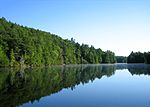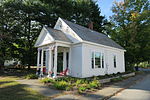Mashapaug Lake
Lakes of Tolland County, ConnecticutNipmuck State ForestProtected areas of Tolland County, ConnecticutReservoirs in ConnecticutUnion, Connecticut

Mashapaug Lake is a 297-acre (1.20 km2) lake surrounded by Bigelow Hollow State Park and Nipmuck State Forest in the town of Union in northeastern Connecticut. The lake has a maximum depth of 39.5 feet (12.0 meters), and an average depth of 15 feet (4.6 meters). Its normal surface elevation is 706 feet (215 m). The lake is very popular with fishermen and boaters from the area, and can also be used for swimming.
Excerpt from the Wikipedia article Mashapaug Lake (License: CC BY-SA 3.0, Authors, Images).Mashapaug Lake
Crawford Drive,
Geographical coordinates (GPS) Address External links Nearby Places Show on map
Geographical coordinates (GPS)
| Latitude | Longitude |
|---|---|
| N 42.0167 ° | E -72.1333 ° |
Address
Mashapaug Pond
Crawford Drive
01521
Connecticut, United States
Open on Google Maps







